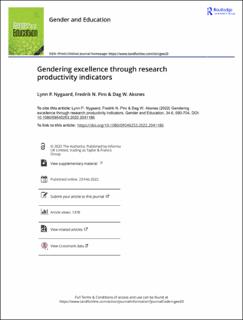Gendering excellence through research productivity indicators
| dc.contributor.author | Nygaard, Lynn Parker | |
| dc.contributor.author | Piro, Fredrik Niclas | |
| dc.contributor.author | Aksnes, Dag W. | |
| dc.date.accessioned | 2022-11-04T12:11:35Z | |
| dc.date.available | 2022-11-04T12:11:35Z | |
| dc.date.created | 2022-04-06T15:20:59Z | |
| dc.date.issued | 2022 | |
| dc.identifier.issn | 0954-0253 | |
| dc.identifier.uri | https://hdl.handle.net/11250/3030172 | |
| dc.description.abstract | As the importance of ‘excellence’ increases in higher education, so too does the importance of indicators to measure research productivity. We examine how such indicators might disproportionately benefit men by analysing extent to which the separate components of the Norwegian Publication Indicator (NPI), a bibliometric model used to distribute performance-based funding to research institutions, might amplify existing gender gaps in productivity. Drawing from Norwegian bibliometric data for 43,500 individuals, we find that each element of the indicator (weighting based on publication type, publication channel, and international collaboration, as well as fractionalization of co-authorship) has a small, but cumulative effect resulting in women on average receiving 10 per cent fewer publication points than men per publication. In other words, we see a gender gap that is not only caused by a difference in the level of production but is also amplified by the value ascribed to each publication. | en_US |
| dc.language.iso | eng | en_US |
| dc.title | Gendering excellence through research productivity indicators | en_US |
| dc.title.alternative | Gendering excellence through research productivity indicators | en_US |
| dc.type | Peer reviewed | en_US |
| dc.type | Journal article | en_US |
| dc.description.version | publishedVersion | en_US |
| dc.source.journal | Gender and Education | en_US |
| dc.identifier.doi | 10.1080/09540253.2022.2041186 | |
| dc.identifier.cristin | 2015714 | |
| dc.relation.project | Norges forskningsråd: 295817 | en_US |
| cristin.ispublished | true | |
| cristin.fulltext | original | |
| cristin.qualitycode | 2 |
Tilhørende fil(er)
Denne innførselen finnes i følgende samling(er)
-
4 - Academic Publications / Vitenskapelige publikasjoner [325]
Academic Articles and Book Chapters -
Publikasjoner fra Cristin [357]
